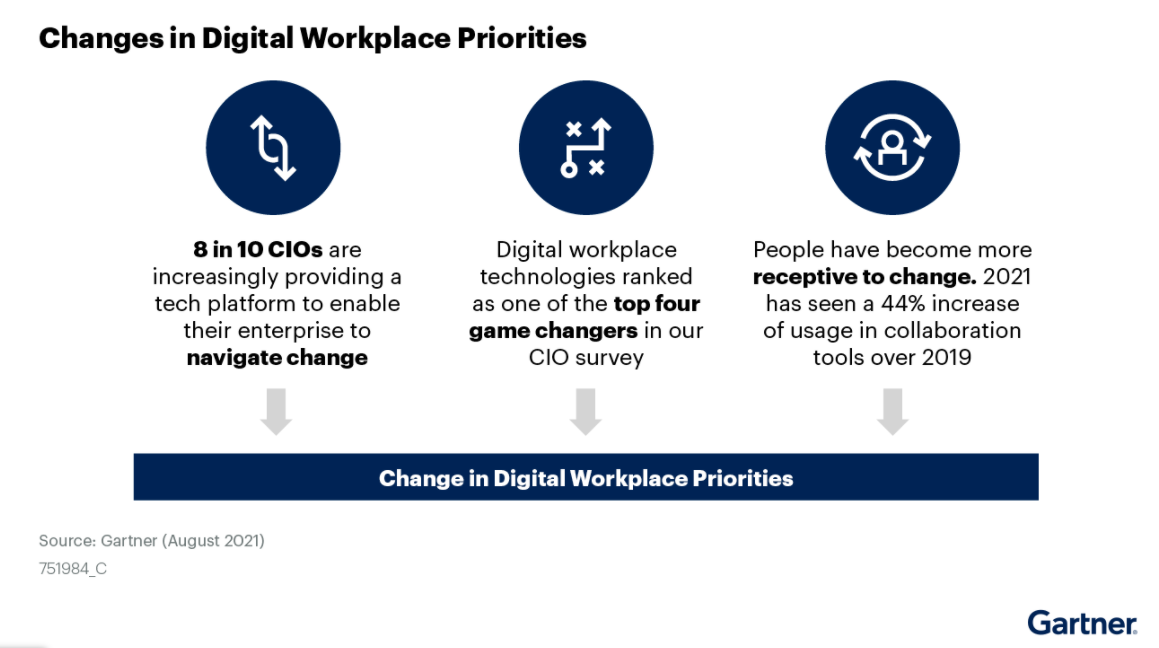Introduction to the digital workplace
An influx of new technologies combined with the shift to remote work means IT teams must do more to support the business, and 2022 will be no different. In the wake of recent years, Forrester predicts 70% of companies will pivot to a work-from-anywhere model. This shift requires new hybrid and virtual office models to empower employees to be happier at work while driving better results for the organization.
For IT leaders with already tight budgets, it is necessary to prioritize technology that will help you save money, make money or stay secure. For the employees on the frontline, the digital employee experience will almost always fall into one of those categories, if not multiple. The key is to align IT’s contribution to the broader strategic initiatives of the organization.
In order to achieve these goals, Gartner has identified a number of key future of work trends:
- Work has become more distributed.
- More processes are being automated; automation continues to expand beyond workflow and robotic process automation (RPA).
- Teams are becoming more agile and interdisciplinary.
- Everything is measured and tracked.
- Services are becoming touchless and virtual.
pillar one: strategic IT investments in technology that enable the digital workplace
In order to support a distributed workforce, IT workers are reporting that they have to work more hours than ever before. According to a recent PWC survey, more than 70% of respondents said they are working longer hours. But despite the increase in work, only 25% of respondents said their budgets have increased.
While IT leaders have to balance tight budgets and longer hours with ever-expanding technology needs, the key is to focus on strategic IT investments that enable the digital workplace. From moving to the cloud to implementing automation, or rapidly scaling support tickets, IT must show how investments make a positive impact across the business.
Image from Gartner

IT leaders need clear visibility of their invoices, assets, and processes to ensure the quality of services they deliver to their users and ultimately the effectiveness of the collaboration tools they are providing to power the business.
pillar two: a positive, IT-driven user experience
Over the past couple of years, we have seen employees’ dissatisfaction with traditional work arrangements cause an increase in turnover, and ultimately a reduction in productivity.
Put simply, employees want to work where they want, with tools that enable effective communication. Because of these changes, the need to support new working patterns has enabled IT leaders to massively accelerate the pace of digital workplace adoption.
According to Gartner, “the digital workplace is now recognized as a critical component in organizations’ ongoing resiliency.” It is critical that IT has the tools and technology to support the new digital workplace. Additionally, by deploying a robust work-from-anywhere strategy, organizations can reap the benefits of the mobile-first digital workplace:
- Reduce infrastructure cost in an all wireless workplace by 34%
- Increase business productivity an average of $9.2M per 5000 users by migrating to an all-wireless workplace
- Reduce hours spent on-boarding and performing adds, moves, and changes in all wireless workplaces by 75%
Building a strong digital workplace can also help drive productivity and happiness. After all, we all want to enjoy our work and to balance personal and work lives. New technologies mean employees can work faster and avoid the frustration that comes with being slowed by distractions and irrelevancies that divert them from their goals. And ultimately, employees can improve the quality of their output, be more strategic and spend time on high-value, satisfying work.
pillar three: security of software, endpoints, and people
Cybersecurity will become an even greater concern in 2022 as a result of organizations supporting a significant remote workforce. In Cisco’s Future of Secure Remote Work Report, 85% of all respondents reported that cybersecurity is extremely important or more important than before the pandemic. The web of connected technologies that enable organizations to profit from a digital workplace also presents an increased area of vulnerability.
Reports are showing that cybercrime will cost companies $6 trillion globally by the end of 2021:
- 45% of all breaches include hacking
- 22%involved phishing
- 70% of business leaders believe their exposure to cybercrime will continue to put their companies at risk.
One key concern is around how data is being accessed and how to secure it effectively. Similar to the first pillar, organizations need to think more strategically about cybersecurity investments and how to best protect workers, data, and equipment. Jack Mannino, CEO of security firm nVisium, says “The shift to remote work has prompted many organizations to make significant new investments in their IT systems and infrastructure. While the shift has already happened for many, the security debt created in the process has not been addressed in many places. Securing a remote workforce requires a different mindset and presents an expanded perimeter for an attack.”
For many organizations, this means deploying one, or more, Unified Endpoint Management (UEM) solutions. These solutions can help protect devices, ensure data doesn’t end up in the wrong hands and provide critical capabilities to secure a digital workplace. We find that 20% of our installed user base relies on more than one UEM to manage their devices. This is especially true in enterprises.
But without proper oversight, UEMs can fail to achieve their full value. The key here is the strategic use of resources to empower the organization. brightfin’s technology centralizes your view of IT assets, invoices, and UEM systems to help IT leaders deliver a powerful digital workplace.




